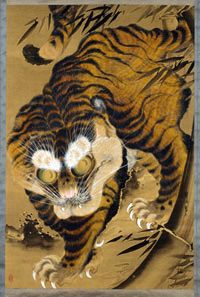 | "Untamed Beauty: Tigers in Japanese Art" is an important exhibition for all those fascinated by the varied aspects and unique styles of Japanese traditional art, as it focuses on one of the most interesting themes : the tiger. Through 18 works of art, made in the 18th - 20th century by some of the most important and popular Japanese artists, complemented by two woodblock prints, the curators present the image of the tiger in that unique country. The pieces selected for the show come from the collection of Harriet and Edson Spencer. The presence and importance of the tiger in Japanese theme is fascinating, mainly because although these feared and beautiful beasts exist in continental Asia, they are not indigenous to Japan. So the absence of the real animal, which could be used as a model by artists, led to the creation of fantastical images and interpretations of their qualities and appearance, mainly under Chinese influence. |
Even if until modern times few of the artists saw a live tiger, the sheer number of works depicting it was astounding, ranging from paintings to the woodblock prints.
"Untamed Beauty : Tigers in Japanese Art" also presents how the artists not only tried to depict the physical characteristics of the tiger, often portraying it as a mythological animal, but also to express some of the spirit of the tiger, by placing the animal in a symbolic environement. An example featured in the show are the works made by artists such as Kano Tsunenobu (1636-1713) and Katayama Yokoku (1760-1801), who choose to represent the mighty tiger emerging from bamboo forests, the bamboo being a traditional symbol for strength. At first, Japanese artists learned to paint mainly by copying the works of the masters. During the Edo period (1615 - 1868) the Western influence appeared and rapidly grew, as books on anatomy, botany and zoolgy were brought to the country by merchants, helping the artists to reevaluate their views and conceptions on the natural world. Later, in the 19th century, this exposure to Western techniques and especially the chance of seing the first real live tigers brought to Japan led to much more realistic depictions.
Photo : stlouis.art.museum
2007-08-24

































